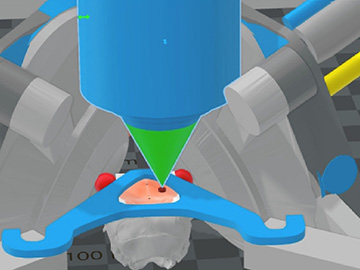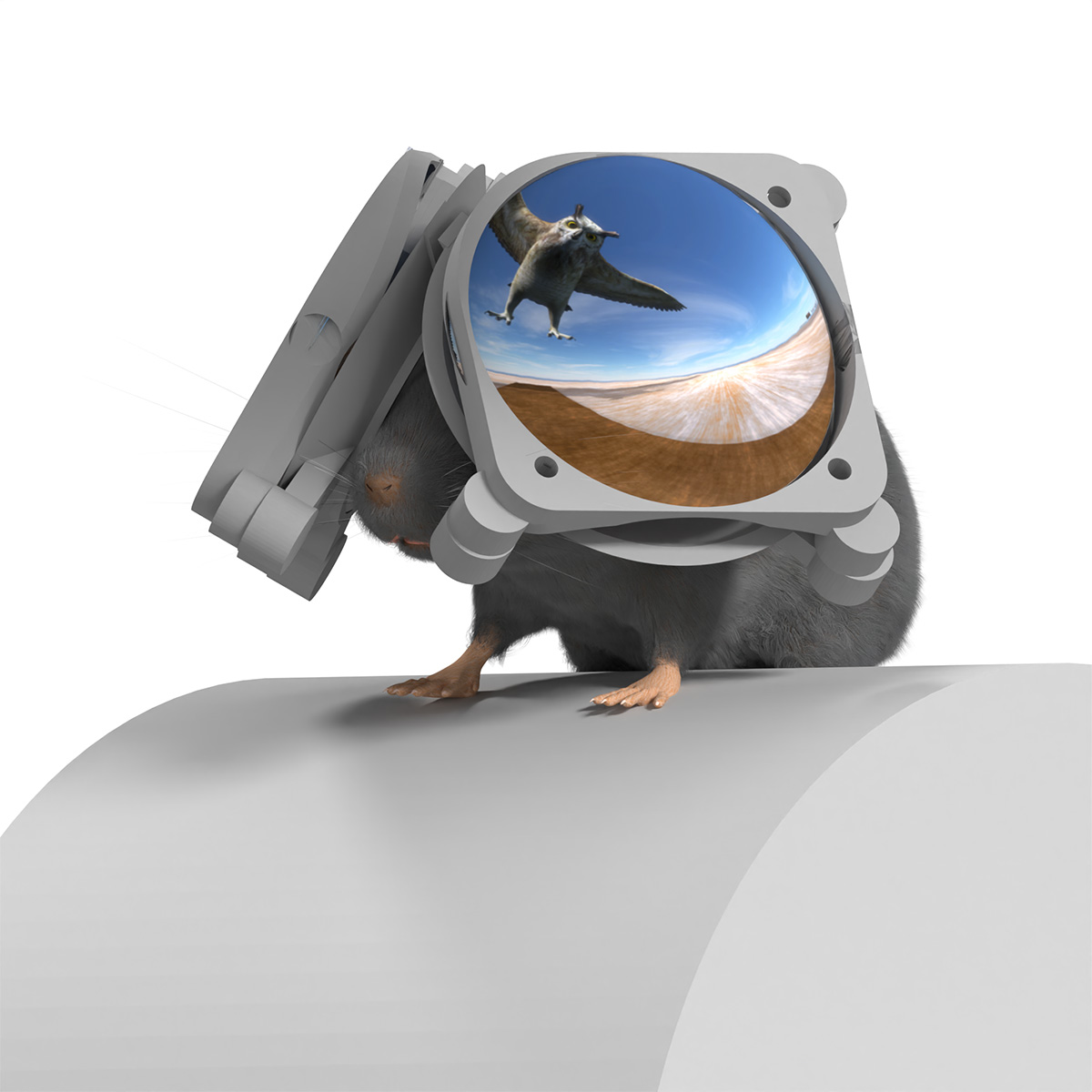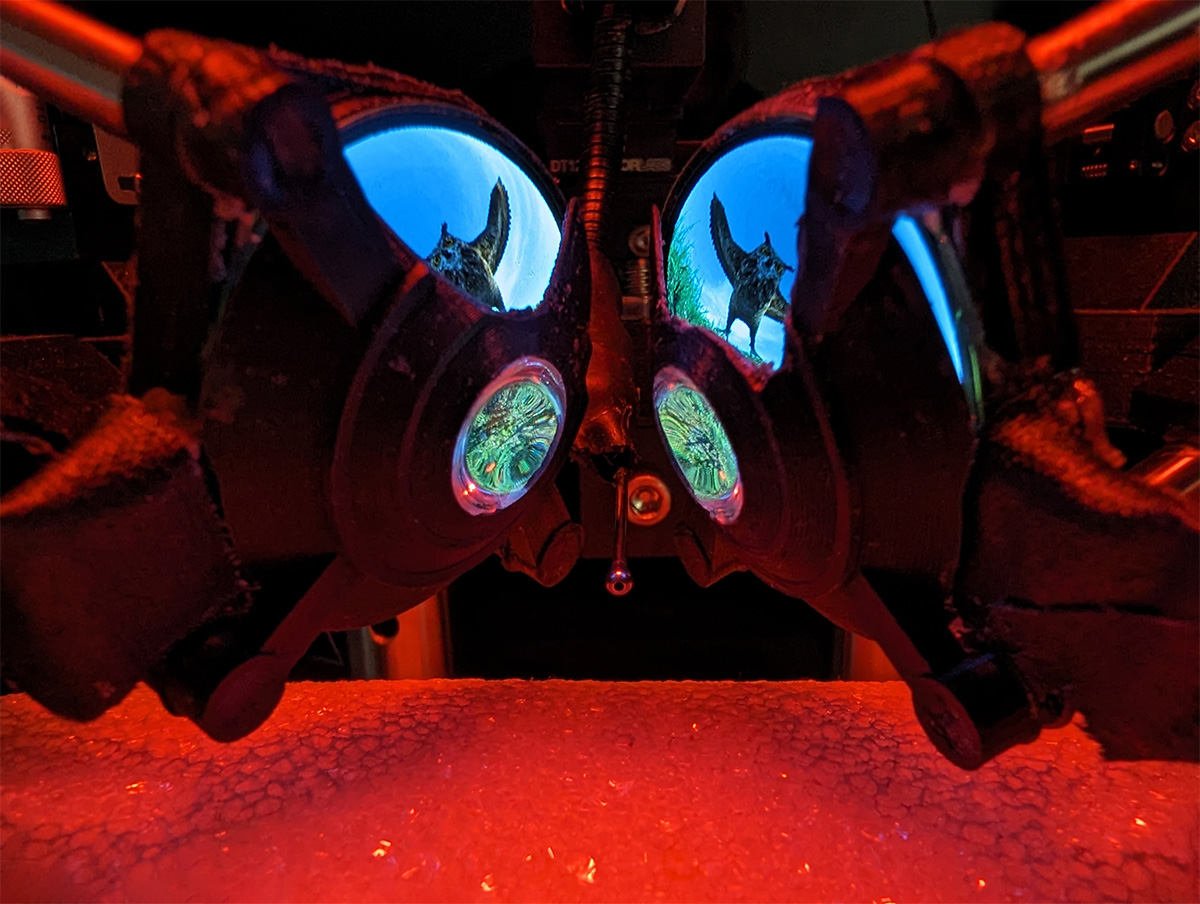A team at Northwestern University, USA, has devised virtual-reality “goggles,” each side of which consists of a circular OLED screen and a meniscus lens. The setup reportedly enables previously difficult experiments simulating responses to stimuli such as an attack by an overhead predator, shown in this artist’s illustration. [Image: Dom Pinke/Northwestern University]
By the thousands, lab mice have been run through mazes, given rewards or mild shocks, and otherwise poked and prodded to elicit secrets of neurobiology that might someday be applied to human behavior and disease. But certain important situations in the mouse world—such as the rodents’ response to an owl or hawk swooping down from overhead—have been tough to simulate in the lab while still allowing a look at the neural activity inside the mouse’s skull.
The research team of neurobiologist Daniel Dombeck at Northwestern University, USA, has now offered a possible solution that would warm the heart of any hard-core gamer (Neuron, doi: 10.1016/j.neuron.2023.11.019). The team has engineered a tiny, slightly outrageous-looking set of virtual-reality (VR) “goggles” for lab mice. The goggles sit above the lab animal’s head, projecting an immersive, 3D field of view to the experimental subject—while still giving scientists room to peer into the mouse’s brain and watch firing neurons at work.
In a press release accompanying the report, Dombeck described the goggles as “small, relatively cheap and pretty user friendly.” Those virtues, he thinks, could make VR a more accessible tool in future experiments in the neurobiology lab.
From flat screens to goggles
This is not the first time virtual reality has been used to enable experiments involving laboratory mice. Indeed, Dombeck’s lab has been working with VR systems for 15 years. Those previous efforts, however, have involved large, planar projection screens in front of and beside the mouse.
Such systems, while clever, provide only a partial field of view, fall short of a true 3D experience and don’t allow a realistic simulation of an overhead threat. They also permit aspects of the outside lab environment to remain visible to the mouse during the experiment. Dombeck compares the mouse’s experience in such old-school VR setups to “watching a TV in your living room … There are cues around you, telling you that you aren’t inside the scene.”
To get around those shortcomings, Dombeck’s team followed the lead of VR headset makers to create a small set of VR goggles for lab mice, which the team calls Miniature Rodent Stereo Illumination VR, or iMRSIV (pronounced “immersive”). Unlike VR devices such as the Oculus Rift, however, the Dombeck lab’s mouse version doesn’t strap directly onto the animal’s head. Instead, the goggles sit on a bracket above the mouse, allowing the animal to peer up into the display from the goggles. The compact goggles, filling the visual field of each eye, give the animal a fully stereoscopic view of the scene.
Designing iMRSIV
A view from inside the iMERSIV goggles. [Image: Dom Pinke/Northwestern University]
Achieving this setup required the team to solve an array of optical problems to accommodate just how mice actually see the world. The researchers began by using a standard model of the mouse eye and measuring how a checkerboard pattern displayed on a simulated retina and on the retina of an extracted mouse eye. This gave them a testbed for designing and testing iterations of the iMRSIV system.
Multiple design rounds then converged on a basic optical setup combining a positive meniscus lens (a convex-concave lens thicker at the center than at the edges) and a small, curved illumination display. A software-enabled “fisheye shader” was added to the displayed view to compensate for small distortions in the optical setup.
The researchers next had the lenses custom-ground, and used a 400×400-pixel, flexible, round OLED screen for the display. They then 3D-printed the parts to hold the screen and lens, as well as the mounting frame. Tests of the apparatus revealed that it would accurately project the checkerboard pattern onto the mouse’s retina as expected—setting things up for experiments with live mice.
Fleeing and freezing
In those experiments, the mouse jogged on a cylindrical treadmill with its head fixed beneath the goggles, which covered the animal’s entire field of view. The team ran a variety of behavioral tests, including one involving an overhead visual scene simulating a sudden, looming menace from above. The team found that the fleeing and freezing responses of the mice to these iMRSIV tests mimicked those seen in the rodents in real-world, open-field experiments.
A key advantage of the iMRSIV setup, the researchers suggest, is that it provides such immersive, realistic overhead simulations for behavioral experiments while still allowing sufficient room to measure actual neuronal activity. The researchers did this by surgically opening a “window” through the mouse’s skull and mounting a two-photon microscope objective in the space between the two VR displays. The setup allowed two-photon calcium imaging of neuronal activity, the location of which shifted as expected as the VR display confronted the mice with new situations.

The iMERSIV system allows real-time calcium imaging of neuronal activity during the mouse’s behavior, by placing a two-photon microscope objective between the separate elements of the VR goggles—something not possible previously with overhead-stimulus experiments. [Image: D. Pinke, J.B. Issa et al., Neuron 111,1, doi: 10.1016/j.neuron.2023.11.019 (2023); CC-BY-NC 4.0]
The team’s measurements also suggest that the mice under the iMRSIV goggles may learn faster than those in experiments with previous VR systems using external screens. “After the first session … they knew where to run and looked to the right places for rewards,” Dombeck said in a press release. “We think they actually might not need as much training because they can engage with the environment in a more natural way.”
Toward head-mounted displays for mice?
The team thinks its iMRSIV technology could enable a variety of neurobiology researchers to conduct experiments that were difficult or impractical with previous VR systems, and that better remove laboratory distractions from the picture. The new paper’s authors do acknowledge some limitations in the current iteration, though. In particular, iMRSIV, unlike other lab VR approaches, at present doesn’t allow for tracking of eye position or pupil size; Dombeck’s group thinks this will be important add-on for future versions.
The team also has big plans for other aspects of this little device, including higher-resolution screens and even bringing smell, sound and tactile simulation into the VR mix. And while the current iMRSIV setup limits experiments to fixed mice atop a moving treadmill, the authors write that “with future miniaturization, goggles small and light enough to be carried by a freely moving mouse might be achievable.”


